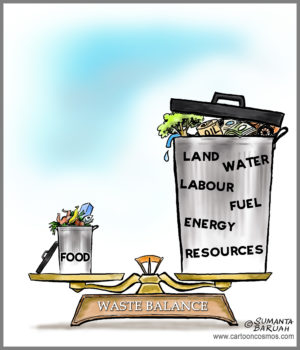
Remember this one time you had a really bad craving for something sticky and sweet and you found a forgotten jar with peanut butter in the cupboard. You were not sure when you bought it, but it looked absolutely OK. You opened it and had the most delicious peanut butter and jelly toast ever, and then…
Nothing really happened. You did not get sick in the stomach, you did not throw up, you did not get poisoned.

You just felt happy and content and had the energy for a few miles run. That’s because if something looks good and edible even after its expiry date, it most probably is. It would not be an overstatement even if we say that chances something is OK beyond it expiry date are as good as something being bad even if the label says it is safe to eat it today.
Because this is (obviously) a jar with butter, not a block of concrete – what’s written on its “Best By” label it is not actually set in stone. Yes, the printed dates are just advisory regulations, not the Ten Commandments written on stone tablets that should be blindly abided. In other words, they are useful guiding lights, yet in many cases, the ‘best by’, ‘sell by’, ‘use by’ and all other safety and quality dates are overrated.
National food regulation agencies enforce food producers to label their products so that customers are informed about the origin, content and qualities of the stuff they buy. And that’s the way it should be, there’s no questioning about the necessity of regulations.
When it comes to individual consumer decisions though, you should trust your gut, literally. If its colour looks as it is supposed to look, if it smells like it usually smells, if there are no visible signs of some alien life invading it, or in one word if it is not suspicious, then it would be delicious.
But why bother, you may ask. Why make those simple checks and not just throw it away and go to the store for a fresh one? It’s just a 99p can of tuna. I can afford a new 99p can of tuna and live happily ever after. Sure you can, but…And here we start with the long and scary list of but’s that should convince you that reading food labels as if they are the Holy Bible is not something a responsible and caring for the future citizen should do.
 Food waste is a huge, really huge issue, especially if you have in mind the number of people who are living in food insecurity every single day. From all the numbers out there, here are the ones that are really frightening:
Food waste is a huge, really huge issue, especially if you have in mind the number of people who are living in food insecurity every single day. From all the numbers out there, here are the ones that are really frightening:
– According to the most recent estimations by UN Food and Agriculture Organization (FAO) 1.3 billion tonnes of food were wasted last year—four times the amount needed to feed the 795 million people who suffer food insecurity.
– From the food that does reach our shelves and refrigerators, it is estimated that up to 20% goes to the bin with 90% of it thrown away too soon.
This means that in 9 out of 10 cases we waste food that should not be wasted.
Wasted food means also wasted water (21% of all freshwater in America is used to produce food that wouldn’t be eaten), and wasted resources, and labour, and love. Yes, love, because someone somewhere has been taking care for quite some time for that cherry tomatoes before you forgot them at the back of the fridge and eventually got rid of them.
When it goes to the landfill, wasted food is much more than garbage. It causes about 10% of global greenhouse gas emission.
So there is a three-way damage effect of thrown away food. First, it does not feed any of the 800 million people living in food insecurity. Second, it uses the scarce natural resources for no good, and third, while decomposing it pollutes those resources that are yet to be used. These are more than enough reasons for any of us to have no excuse for throwing away any food whatsoever.
The steps to a food-waste-free household are neither many nor too complicated. Once you get into this waste-less mindset, you would see that both your groceries bill and your trash bag will become smaller.
- Shop smartly. There are many aspects to this, but the basics are – plan ahead, make a list, know what you need for the meals you plan to cook, don’t buy stuff just because it’s on sale, don’t buy anything impulsively and stick to your list.
- Store food properly. Read our post with tips for different storage techniques for different products. Have in mind that when reading the food packaging labels, it is much more important to pay attention to the section with storage guidelines than the expiry date. If you put the food in its right place it will stay safe and sound even beyond its ‘best before’ date, and vice verse.
- Don’t experiment too much. If you are an experienced chef, you can do whatever meal with whatever you have. We guess you are not. So the more familiar products you buy, the less the chances that you will not like them, not cook them, not store them properly.
- Apply the FIFO principle as much as possible (even if you are not an accountant). Arranging food in the fridge properly helps with that. When you come home from the supermarket don’t just trust everything in the fridge because older products will be stuck behind the fresh ones. And hence easily forgotten there until it’s too late.

- Get creative. (even if you are an accountant 😉 ) A brown banana might not taste so good by itself, but it would do an amazing job with some yoghurt in the blender for a boosting smoothie start of your day. Made too much sweet-potato-and-ginger soup? Put half of it in a jar and freeze it for a late Sunday night when you’ve just come home from the mountains with nothing cooked for dinner.
- Learn to understand the sell-by and best-before dates. Please do. Here’s where we started from. The labels. They vary from country to country, and in the US even from state to state. ‘Sell by’ date is for retailers – it tells them the time frame a product should be placed on the shelves. ‘Best by’ and ‘eat by’ are often manufacturers’ suggestions for peak quality and not strict indicators of whether a food is still safe for consumption. This has also a lot to do with the point of experimenting and buying more stuff that you know and less that you don’t know. Imagine you buy a brand of cheese for the first time and you put it in the fridge and forget it’s there to find out a few weeks later its expiry date was ten days ago. Your most probable reaction would be “I’m not sure what this cheese is anyway and I have no idea how it should taste, so I’ll just play it safe and throw it way.” You would do that, wouldn’t you? But if it is the cheese you’ve been buying for years, you can tell for sure if it is good or bad by the way it looks and smells, not by the date on its label, right.
- Get into the 21st century. Meaning – use all the available technology to plan, shop, cook and store food. CozZo is an iPhone app that will make your life easier not only when it comes to planning what to buy, but also with knowing what you’ve bought last week, when it is supposed to go bad and how much of it is still in your fridge. Sounds like your own personal butler, doesn’t it?

How does it work? Keeping track of your life is important not only when it comes to sports and training, bookkeeping or family photo albums. What you buy, how long it lasts, how much you need of it for a week, a month – that’s the basis of a good-maintained household. It’s the best way to start consciously following up your buying and eating habits and adjust the first to the latter.
An app like CozZo helps you with that and requires as little extra effort on your behalf as possible. It monitors your purchases, tells you each morning that something is about to expire and should be eaten today, and shows you how much of a product was thrown away because you had too much of it. So once you get into the habit of filling in your “Use Within” period estimates in the app, it will quickly become your pocket reference and advisor on what you have, when you need to buy something and how much of it you actually need, so that nothing goes to waste. In no time you would see that expiry dates on the labels would become less meaningful to you. Experience and CozZo coaching feedback would be enough for you to know how long a product can last in your home with your family eating habits.
In a nutshell
What we want to say is that at the end of the day you should act according to your better judgment when reading food packaging. Because if you are the conscious, caring and clever person you want to be, reducing your household food waste footprint should be a battle with a fight. It would give you both peace of mind and piece of money – you will not be contributing unnecessarily to the climate change problems on a global level and will be saving some extra cash for whatever suits you on a personal level. It cannot get more win-win than that.


Comments are closed, but trackbacks and pingbacks are open.